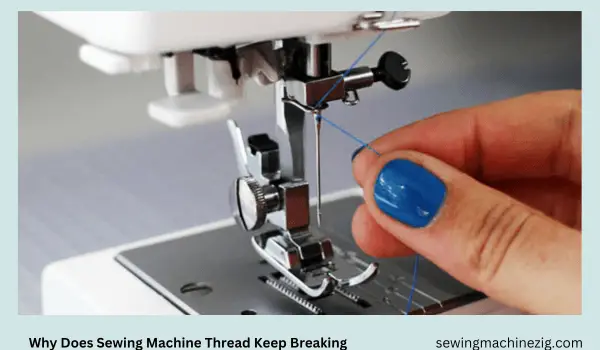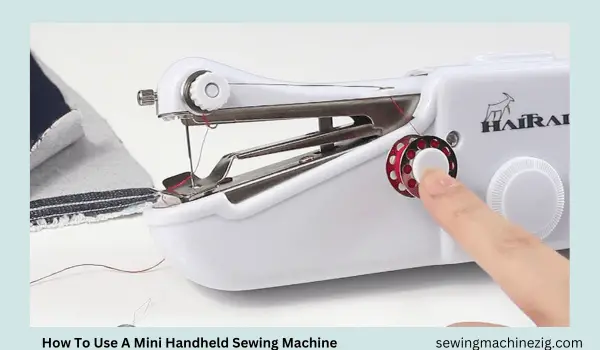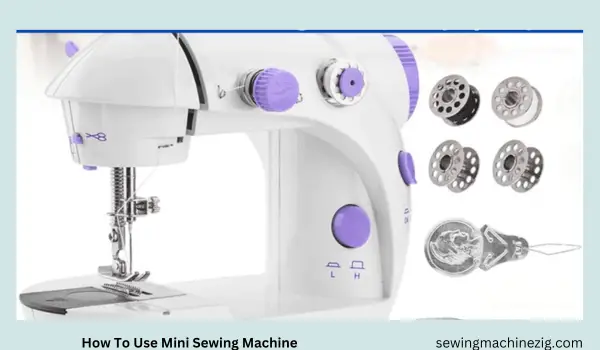
A sewing machine is an essential tool for anyone interested in sewing. It makes sewing faster and more efficient, allowing for intricate and complex designs to be easily created. However, there are times when the sewing machine may fail to stitch, causing frustration and delays in completing a project. There are several reasons why a sewing machine may not stitch, ranging from user error to mechanical issues.
Thank you for reading this post, don't forget to subscribe!Identifying the root cause of the problem is crucial to finding a solution and getting back to sewing. In this article, we will explore why sewing machines won’t stitch and some of the common reasons and provide possible solutions to resolve the issues.
In this guide, we will provide step-by-step solutions to why sewing machine won’t stitch. A sewing machine is a complex piece of equipment that can encounter various problems that can prevent it from stitching correctly. Here are eight major issues that can cause a sewing machine not to stitch, along with their long solutions:
14 Types of major problems why sewing machines won’t stitch and solutions:
1. Bent Needle
If the needle is bent or damaged, it can cause the sewing machine not to stitch correctly. Bent needles can also cause skipped stitches or break the thread.
Solution: To solve this issue, why sewing machine won’t stitch, replace the needle with a new one. Make sure that the new needle is the correct size and type for the fabric being used. Also, ensure that the needle is inserted correctly and is facing the right direction.
2. Tension Issues
Tension issues are a common problem that can cause a sewing machine not to stitch correctly. The thread tension is essential in ensuring that the upper and lower threads are balanced and producing even stitches. When the tension is too tight, the thread can break, and when it is too loose, the thread can bunch up, resulting in uneven stitches.
Solution: To solve tension issues, first, ensure that the machine is threaded correctly. Then, adjust the tension according to the machine’s manual instructions. Make sure that the upper thread and bobbin thread are correctly tensioned. Test the stitches on a scrap piece of fabric to ensure that the stitches are even. This may also solve the issue of why sewing machine won’t stitch.
3. Tangled thread
A tangled thread can prevent a sewing machine from stitching. This can happen if the thread gets caught around the spool or if the thread gets tangled in the bobbin case.
Solution: Unwind the thread from the spool and re-thread the machine. Ensure that the bobbin case is also free of any tangled thread. It is essential to make sure the thread is unwinding smoothly from the spool to prevent tangles.
4. Dirty Machine
Dirt and debris can accumulate in the sewing machine, causing it not to stitch correctly. Dirt and debris can affect the machine’s moving parts, making them stiff and difficult to operate.
Solution: To solve this issue, clean the machine regularly. Use a soft cloth to wipe down the machine’s exterior and a brush to clean the interior. Remove the needle plate and clean the bobbin area.
5. Wrong Bobbin Thread
Using the wrong bobbin thread can cause the sewing machine not to stitch correctly. The bobbin thread should be the same type and weight as the upper thread.
Solution: Check the machine’s manual for the correct type of bobbin thread to use. If the bobbin thread is incorrect, replace it with the correct thread.
6. Incorrect Thread Type
Incorrect threading is one of the most common reasons why a sewing machine won’t stitch. Ensure that the thread is correctly threaded through the machine’s various components, including the needle, tension discs, and bobbin.
Solution: Re-thread the sewing machine and ensure that the thread is correctly threaded through all components also replace it with the correct thread. Always make sure you are threading the machine correctly.
7. Incorrect Presser Foot
Using the wrong presser foot can cause the sewing machine not to stitch correctly and people get worried about why sewing machine won’t stitch. Different presser feet are used for different sewing techniques.
Solution: Check the machine’s manual for the correct presser foot to use. If the wrong presser foot is being used, replace it with the correct one. Make sure that the presser foot is securely attached to the machine.
8. Bobbin Winding Issues
Bobbin winding issues can cause the sewing machine not to stitch correctly. If the bobbin is not wound correctly, it can cause the thread to tangle or bunch up.
Solution: To solve this issue, ensure that the bobbin is wound correctly. Make sure that the bobbin is placed correctly in the bobbin case and that the thread is pulled through the correct thread guides. Test the machine on a scrap piece of fabric to ensure that the stitches are even.
9. Jammed machine
A jammed sewing machine can prevent it from stitching. This can happen if the fabric gets caught in the machine.
Solution: Carefully remove any jammed fabric from the machine and ensure that the machine is properly threaded. Always make sure to turn off the machine before attempting to remove the jammed fabric.
10. Timing Issues
Timing issues can cause the sewing machine not to stitch correctly. If the machine’s timing is off, the needle and bobbin may not meet perfectly, causing the machine not to stitch.
Solution: To solve this issue, the machine may need to be serviced by a professional technician. If the machine is still under warranty, contact the manufacturer for service. If the machine is out of warranty, look for a reputable sewing machine repair shop.
11. Incorrect stitch settings
Incorrect stitch settings can cause a sewing machine not to stitch correctly and you may don’t understand why sewing machine won’t stitch.
Solution: Select the correct stitch settings according to the fabric. Different fabrics require different stitch settings, so always refer to the instructions to ensure the correct settings are selected.
12. Machine is not cleaned and oiled regularly
If a sewing machine is not cleaned and oiled regularly, it can cause why sewing machine won’t stitch issue. Over time, dirt and debris can build up inside the machine, causing it to malfunction. This can result in skipped stitches, broken needles, or even damage to the machine’s internal parts.
Solution: To prevent problems caused by lack of cleaning and oiling, typically, this involves cleaning the machine after every project and oiling it every 8 to 10 hours of use. To clean the machine, use a soft brush to remove any lint or debris from the bobbin area and feed the dogs. Wipe down the machine with a soft, dry cloth to remove any remaining dust. For oil, use high-quality sewing machine oil.
Regular maintenance will not only help prevent sewing machine issues, but it will also solve your issue why sewing machine won’t stitch and extend the life of the machine.
13. Uneven feed dogs
Feed dogs are small, jagged teeth that protrude from the sewing machine’s needle plate and move the fabric as it is stitched. If the feed dogs are not working correctly, the fabric may not move evenly, causing stitching problems such as skipped stitches, uneven stitches, or fabric jams this may cause the machine why sewing machine won’t stitch on your project.
Solution: To fix uneven feed dogs, first, check to see if they are dirty or obstructed. If there is debris in the feed dog area, gently clean it with a soft brush. If the feed dogs are still not moving evenly, the problem may be due to the presser foot pressure being set too high or too low.
Adjust the pressure as needed and also check the feed dog height. If the feed dogs are too high, they can damage the fabric or cause it to bunch up. If they are too low, they won’t grip the fabric properly, causing feeding issues. Adjust the feed dog height. Hope this will also solve your issue of why the sewing machine won’t stitch on your project.
14. Clogged needle plate
The needle plate is a metal plate located under the needle and presser foot of a sewing machine. If it becomes clogged with lint, dust, or fabric fibers, it can cause stitching problems. Why sewing machine won’t stitch it’s because of clogged needle plates can cause the machine to jam, skip stitches, or even break needles.
Solution: To fix a clogged needle plate, start by turning off the machine and unplugging it from the power source. Remove the needle plate and brush away any debris with a soft-bristled brush or lint roller. Use a small vacuum or a can of compressed air to remove any remaining debris. If the plate is heavily clogged, use a soft cloth moistened with rubbing alcohol to clean it.
It’s important to avoid using sharp or pointed objects to clean the needle plate as this can scratch the surface and cause further damage.
Conclusion:
Why sewing machine won’t stitch, a sewing machine may stop stitching due to a variety of reasons, such as incorrect threading, a worn or bent needle, insufficient tension, or a malfunctioning machine. Troubleshooting steps may include checking and adjusting the threading, needle, and tension, as well as cleaning the machine. It is important to consult the manual or a professional if necessary.
Regular maintenance and cleaning can also prevent stitching problems from occurring. By addressing any issues promptly and taking steps to prevent future problems, sewers can keep their machines running smoothly and avoid frustration while working on their projects. I hope now you’re fully aware of why sewing machine won’t stitch.
What Is Stitch In Sewing Machine?
In sewing, a “stitch” refers to the pattern of thread that joins fabric together. In a sewing machine, the term “stitch” typically refers to the specific way the machine forms the thread to create a seam or decorative pattern on the fabric.
Sewing machines offer various types of stitches, each serving different purposes:
- Straight Stitch: This is the basic stitch used for most sewing tasks like seaming and topstitching. It consists of a single line of stitches in a straight line.
- Zigzag Stitch: This stitch moves the needle back and forth in a zigzag pattern, allowing for stretch and preventing fabric from fraying. It’s commonly used for finishing edges, appliqué, and sewing stretchy fabrics.
- Overlock Stitch: Also known as a serger stitch, this stitch trims the fabric edge while simultaneously sewing over it, preventing fraying and creating a neat, professional finish.
- Buttonhole Stitch: As the name suggests, this stitch is used for creating buttonholes. It typically involves a series of closely spaced zigzag stitches to reinforce the area around the buttonhole.
- Decorative Stitches: Many sewing machines offer a variety of decorative stitches, ranging from flowers to scallops to hearts. These stitches are often used for embellishment and adding decorative touches to garments or projects.
These are just a few examples of the many stitches available on sewing machines. The specific stitches available can vary depending on the make and model of the sewing machine.
FAQs:
What could cause a sewing machine to stop stitching?
Common reasons include threading issues, worn or bent needles, and tension problems.
How do I troubleshoot my sewing machine if it won’t stitch?
Check the threading, needle, and tension. Clean the machine and consult the manual or a professional if necessary.
Can using the wrong type of needle cause a sewing machine to stop stitching?
Yes, using the wrong type or size of the needle can cause stitching problems or even damage the machine.
Why sewing machine won’t stitch?
Possible reasons include improper needle or thread selection, incorrect tension, or a worn or damaged needle.
What should I do if my sewing machine keeps breaking the thread?
Check the threading, tension, and needle. Adjust as needed, or consider using a stronger thread or a different needle type.
Can a dirty sewing machine cause stitching problems?
Yes, dust, lint, and debris can accumulate in the machine and cause stitching issues. Regular cleaning and maintenance can prevent this.
When should I take my sewing machine to a professional for repairs?
If troubleshooting does not solve the problem, or if there are signs of physical damage or mechanical malfunction, it may be time to seek professional repairs.
.



